
Etruscan was the language of the Etruscan civilization in the ancient region of Etruria, in Etruria Padana and Etruria Campana in what is now Italy. Etruscan influenced Latin but was eventually completely superseded by it. The Etruscans left around 13,000 inscriptions that have been found so far, only a small minority of which are of significant length; some bilingual inscriptions with texts also in Latin, Greek, or Phoenician; and a few dozen purported loanwords. Attested from 700 BC to AD 50, the relation of Etruscan to other languages has been a source of long-running speculation and study, with it mostly being referred to as one of the Tyrsenian languages, at times as an isolate and a number of other less well-known theories.
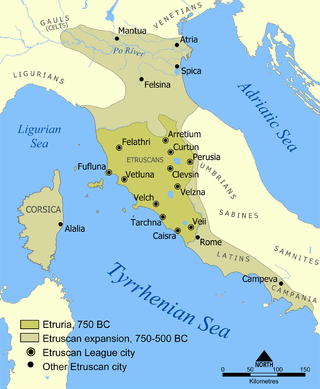
The Etruscan civilization was an ancient civilization created by the Etruscans, a people who inhabited Etruria in ancient Italy, with a common language and culture who formed a federation of city-states. After conquering adjacent lands, its territory covered, at its greatest extent, roughly what is now Tuscany, western Umbria, and northern Lazio, as well as what are now the Po Valley, Emilia-Romagna, south-eastern Lombardy, southern Veneto, and western Campania.
The Old Italic scripts are a family of ancient writing systems used on the Italian Peninsula between about 700 and 100 BC, for various languages spoken in that time and place. The most notable member is the Etruscan alphabet, which was the immediate ancestor of the Latin alphabet used by more than 100 languages today, including English. The runic alphabets used in Northern Europe are believed to have been separately derived from one of these alphabets by the 2nd century AD.

Old Latin, also known as Early Latin or Archaic Latin, was the Latin language in the period roughly before 75 BC, i.e. before the age of Classical Latin. It descends from a common Proto-Italic language; Latino-Faliscan is likely a separate branch from Osco-Umbrian with possible further relation to other Italic languages and to Celtic; e.g. the Italo-Celtic hypothesis.

Palestrina is a modern Italian city and comune (municipality) with a population of about 22,000, in Lazio, about 35 kilometres east of Rome. It is connected to the latter by the Via Prenestina. It is built upon the ruins of the ancient city of Praeneste.

Saint Peter's tomb is a site under St. Peter's Basilica that includes several graves and a structure said by Vatican authorities to have been built to memorialize the location of Saint Peter's grave. St. Peter's tomb is alleged near the west end of a complex of mausoleums, the Vatican Necropolis, that date between about AD 130 and AD 300. The complex was partially torn down and filled with earth to provide a foundation for the building of the first St. Peter's Basilica during the reign of Constantine I in about AD 330. Though many bones have been found at the site of the 2nd-century shrine, as the result of two campaigns of archaeological excavation, Pope Pius XII stated in December 1950 that none could be confirmed to be Saint Peter's with absolute certainty. Following the discovery of bones that had been transferred from a second tomb under the monument, on June 26, 1968, Pope Paul VI said that the relics of Saint Peter had been identified in a manner considered convincing. Only circumstantial evidence was provided to support the claim.
Clusium was an ancient city in Italy, one of several found at the site. The current municipality of Chiusi (Tuscany) partly overlaps this Roman walled city. The Roman city remodeled an earlier Etruscan city, Clevsin, found in the territory of a prehistoric culture, possibly also Etruscan or proto-Etruscan. The site is located in northern central Italy on the west side of the Apennines.
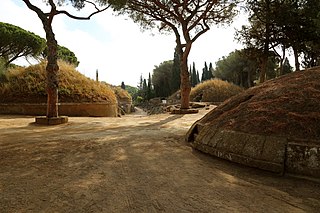
Cerveteri is a comune (municipality) in the Metropolitan City of Rome Capital, in the Italian region of Lazio. Known by the ancient Romans as Caere, and previously by the Etruscans as Caisra or Cisra, and as Agylla by the Greeks, its modern name derives from Caere Vetus used in the 13th century to distinguish it from Caere Novum.
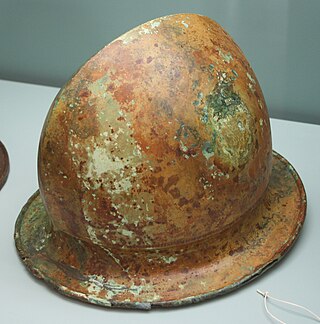
The Negau helmets are 26 bronze helmets dating to c. 450 BC–350 BC, found in 1812 in a cache in Ženjak, near Negau, Duchy of Styria. The helmets are of typical Etruscan 'vetulonic' shape, sometimes described as of the Negau type. It is not clear when they were buried, but they seem to have been left at the Ženjak site for ceremonial reasons. The village of Ženjak was of great interest to German archaeologists during the Nazi period and was briefly renamed Harigast during World War II. The site has never been excavated properly.
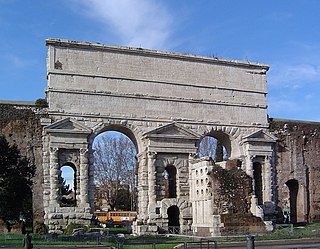
The Porta Maggiore, or Porta Prenestina, is one of the eastern gates in the ancient but well-preserved 3rd-century Aurelian Walls of Rome. Through the gate ran two ancient roads: the Via Praenestina and the Via Labicana. The Via Prenestina was the eastern road to the ancient town of Praeneste. The Via Labicana heads southeast from the city.
Margherita Guarducci, also spelled Guarduci, was an Italian archaeologist, classical scholar, and epigrapher. She was a major figure in several crucial moments of the 20th-century academic community. A student of Federico Halbherr, she edited his works after his death. She was the first woman to lead archaeological excavations at the Vatican, succeeding Ludwig Kaas, and completed the excavations on Saint Peter's tomb, identifying finds as relics of Saint Peter. She has also engaged in discussions on the authenticity of the Praeneste fibula, arguing that its inscription is a forgery.
The gens Alliena or Aliena was a minor plebeian family of the Roman Republic. The first member of the gens to achieve prominence was Lucius Alienus, plebeian aedile in 454 BC. However, the family then slipped into obscurity for several centuries, emerging once more in the first century BC.
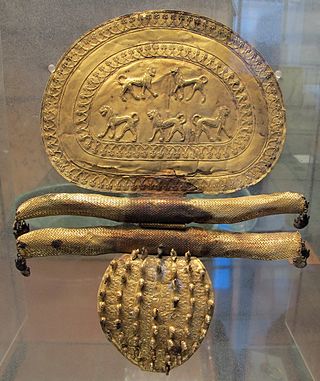
The tomb known as the Regolini-Galassi tomb is one of the wealthiest Etruscan family tombs in Caere, an ancient city in Italy approximately 50–60 kilometres (31–37 mi) north-northwest of Rome. The tomb dates to between 680/675-650 BC. Based on the evidence of the tomb's architecture and its contents, it was built by a wealthy family of Caere. The grave goods included with the two decedents included bronze cauldrons and gold jewellery of Etruscan origin in the Oriental style. The tomb was discovered in 1836 in modern-day Cerveteri in an undisturbed condition and named after the excavators, general Vincenzo Galassi and the archpriest of Cerveteri, Alessandro Regolini. Both of these men had previous experience opening and excavating tombs in the area of Caere.
The gens Obellia was an obscure plebeian family at ancient Rome, known almost entirely from inscriptions.
The gens Belliena or Billiena was a minor plebeian family at ancient Rome. Bellienus is the form that occurs in writers, while Billienus is more common in inscriptions. Members of this gens are first mentioned toward the end of the Republic. Lucius Bellienus obtained the praetorship in 107 BC, but was prevented from obtaining the consulship. The Bellieni occur in history down to the time of Caesar, after which the family faded into obscurity; but others are known from inscriptions.
The gens Servia was a minor plebeian family at ancient Rome. Few members of this gens are mentioned in ancient writers, but a number are known from inscriptions.
The gens Tampia was a minor plebeian family at ancient Rome. Members of this gens are first mentioned in history during the time of Nero, but few achieved any distinction in the Roman state. The nomen Tampius is easily confused with that of Ampius. The most illustrious of the Tampii was Lucius Tampius Flavianus, who held the consulship twice during the latter half of the first century.
The Castellani were a family of goldsmiths, collectors, antique dealers and potters who created a business "empire" active in Rome during the 18th and 19th centuries.

Phoenician metal bowls are approximately 90 decorative bowls made in the 7th–8th centuries BCE from bronze, silver and gold, found since the mid-19th century in the Eastern Mediterranean and Iraq. They were historically attributed to the Phoenicians, but are today considered to have been made by a broader group of Levantine peoples.
The gens Tutia was an obscure plebeian family at ancient Rome. Only a few members of this gens are mentioned by Roman writers, but a number of others are known from inscriptions.












